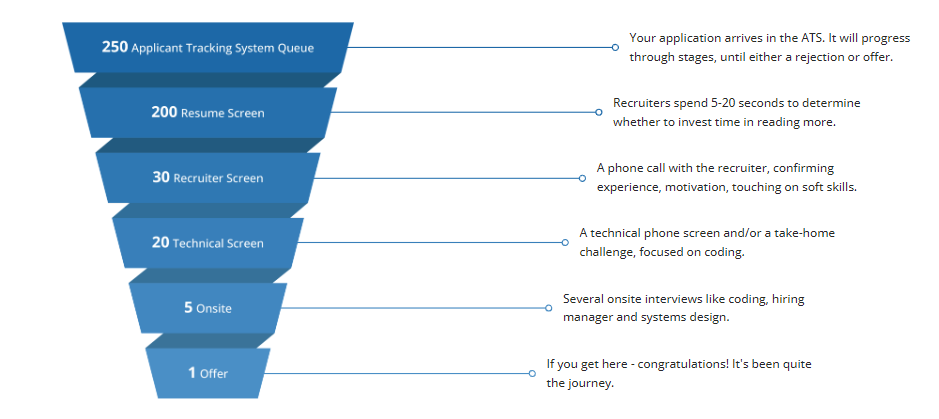It is time to pursue a career in AI and data engineering. Both these professions are in high demand with major salary perks. Stats from Indeed show the average annual salary for the two are around $140,000. Add being future-proof, and with opportunities for highly-scalable advancement to the already promising career path, data and AI jobs rank amongst the best.
The demand for AI and data engineers is high, and every company wants to get the best talent. This makes the top roles at the best companies highly competitive. Knowledge of hiring trends and processes can improve your chances of getting selected, allowing you to optimize your application process, resume style, interview, approaches for technical assessments and beyond.
There are slight differences in the hiring process for data and AI jobs. Entry-level engineers might be selected with general screening, while mid and high-level professionals might need multiple rounds of assessments and interviews. However, the stages are generally similar. We’ll take you through these steps here and provide you some professional tips to get your dream AI job.
Who is involved in the recruitment process?
You’ll directly or indirectly interact with several people during the hiring process. Recruiters, hiring managers, interview panels, and assessment coordinators are common for data and AI jobs. The interview and assessment stages might involve multiple panels or people at different rounds. As a candidate, you will go through a hiring funnel or pipeline to filter the best individual among a pool of applicants. An offer letter awaits you at the bottom while multiple hiring stages take place as we move down the pipeline.

Stepwise hiring process for AI jobs
Step 1: The Application
The application stage is a direct response to the vacancy announcement by the company. Candidates interested in filling the role apply to AI jobs through different mediums. Recruiters then collect applications and test the general eligibility of each candidate. Applicant tracking systems (ATS) are common. In fact, a study by Jobscan showed that over 95% of the fortune 500 companies in the US use ATS.
If we run numbers through a typical hiring pipeline, there are 200 to 250 initial applicants for each job. Almost one-fifth of the applicants are rejected by some talent management software automatically.
Step 2: Resume Review
During the resume review process, recruiters scan resumes for relevant information. Recruiters might have to go through hundreds of CVs daily, so your resume has only a few seconds to make an impression. Most applicants are rejected during this stage. Download the recording of our recent webinar on resume writing for AI engineers if you need professional help.
From our example above, only about 200 applicants make it past ATS software. Recruiters quickly scan through their resumes and filter out the best ones. Only 30 fitting resumes are likely to make it through the next stage.
Step 3: Initial Screening (phone/video interview)
Initial screening is sometimes also called recruiter screening. It is the first point of contact a company might make with you. This screening aims to confirm that you are the right applicant, the information provided through the resume and application is correct, and that the motivation behind applying for the job is there. If everything ticks off, the next step is interviews and assessments. Only 20 applicants from our previous example will make it through this stage.
Step 4: Technical assessment
Technical screening and assessment is a crucial stage. An assessment coordinator, most likely a senior AI engineer, will test your abilities through different phases. This includes checking your familiarity with the technologies used by the company and your programming skills necessary for data or AI jobs. You will be invited for a job interview if the assessment team is satisfied with your technical skills. Continuing from our previous example, fewer than 5 candidates will get on to the interview stage.
Step 5: Job Interview
Congratulations if you are selected for a job interview. This is the final step before the company makes a hire. Only top candidates get to this stage, and making an excellent impression for your job interview is so important. Be on time and believe in yourself. Don’t get dejected if you are not selected, as you now know you are amongst the top candidates, and there will be other opportunities. If you are chosen, well done! It’s time to negotiate your offer letter.
Tips for negotiating your offer letter
- Hiring managers mostly provide a salary range (say 110-145K annually) for data and AI jobs. Negotiate your base salary to fit your experience and responsibilities.
- Make a reasonable counter offer if you are unhappy with the current offer.
- Negotiate and discuss signing and retention bonuses. This could be beneficial for both parties.
- Consider extra benefits like insurance, vacation, or similar perks.
- Don’t be stubborn but help them understand why your request reflects what you deserve.
Joining a dedicated platform like Squadery is a great idea if you are looking for remote data and AI jobs. Apply today for free.
Want to learn more about Squadery? Click here.





